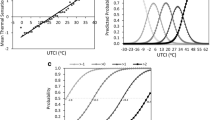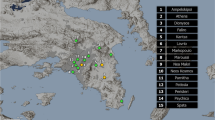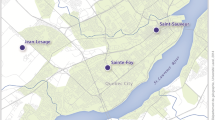Abstract
Human thermal perception is best described through thermal indices. The most popular thermal indices applied in human bioclimatology are the perceived temperature (PT), the Universal Thermal Climate Index (UTCI), and the physiologically equivalent temperature (PET). They are analysed focusing on their sensitivity to single meteorological input parameters under the hot and windy meteorological conditions observed in Doha, Qatar. It can be noted, that the results for the three indices are distributed quite differently. Furthermore, they respond quite differently to modifications in the input conditions. All of them show particular limitations and shortcomings that have to be considered and discussed. While the results for PT are unevenly distributed, UTCI shows limitations concerning the input data accepted. PET seems to respond insufficiently to changes in vapour pressure. The indices should therefore be improved to be valid for several kinds of climates.








Similar content being viewed by others
References
Blazejczyk K, Epstein Y, Jendritzky G, Staiger H, Tinz B (2012) Comparison of UTCI to selected thermal indices. Int J Biometeorol 56 (3):515–535. doi:10.1007/s00484-011-0453-2. WOS:000303461000010
Blazejczyk K, Jendritzky G, Bröde P, Fiala D, Havenith G, Epstein Y, Psikuta A, Kampmann B (2013) An introduction to the Universal Thermal Climate Index (UTCI). Geogr Pol 86(1)
Fanger P (1972) Thermal comfort. McGraw-Hill, New York
Fiala D, Havenith G, Broede P, Kampmann B, Jendritzky G (2012) UTCI-fiala multi-node model of human heat transfer and temperature regulation. Int J Biometeorol 56(3):429–441. doi:10.1007/s00484-011-0424-7. WOS:000303461000003
Fröhlich D, Matzarakis A (2013) Modeling of changes in thermal bioclimate: examples based on urban spaces in freiburg germany. Theor Appl Climatol 111:547–558. doi:10.1007/s00704-012-0678-y
Havenith G, Fiala D, Błazejczyk K, Richards M, Bröde P, Holmér I, Rintamaki H, Benshabat Y, Jendritzky G (2012) The UTCI-clothing model. Int J Biometeorol 56(3):461–470. doi:10.1007/s00484-011-0451-4
Herrmann J, Matzarakis A (2012) Mean radiant temperature in idealized urban canyons—examples from Freiburg, Germany. Int J Biometeorol 56:199–203
Höppe PR (1993) Heat balance modeling. Experientia 49
Höppe PR (1999) The physiological equivalent temperature—a universal index for the biometeorological assessment of the thermal environment. Int J Biometeorol 43:71–75
Höppe P (1984) Die energiebilanz des menschen, PhD thesis. Münchner Universitäts-Schriften, Wissenschaft, Mittelungen Nr. 49
Hwang RL, Lin TP, Matzarakis A (2011). Build Environ 46(4):863–870. doi:10.1016/j.buildenv.2010.10.017
International Union of Physiological Sciences–Thermal Commission (2003) Glossary of terms for thermal physiology. J Therm Biol 28(1):75–106. BCI:BCI200300117033
Jendritzky G, de Dear R, Havenith G (2012) UTCI—why another thermal index? Int J Biometeorol 56:421–428
Kampstra P (2008) Beanplot: A boxplot alternative for visual comparison of distributions. J Stat Softw Code Snippets 1(28):1–9
Ketterer C, Ghasemi I, Reuter U, Rinke R, Kapp R, Bertram A, Matzarakis A (2013) Veränderung des thermischen bioklimas durch stadtplanerische umgestaltung. Gefahrstoffe- Reinhaltung der Luft 7-8/2013:323–329
Lin TP, Matzarakis A, Hwang R L (2010) Shading effect on long-term outdoor thermal comfort. Build Environ 45(1):213–221. doi:10.1016/j.buildenv.2009.06.002
Lin TP, Tsai KT, Liao CC, Huang YC (2013) Effects of thermal comfort and adaptation on park attendance regarding different shading levels and activity types. Build Environ 59(0):599–611. doi:10.1016/j.buildenv.2012.10.005
Lopes A, Lopes S, Matzarakis A, Alcoforado MJ (2011) Theinfluence of the summer sea breeze on thermal comfort in funchal (madeira). A contribution to tourism and urban planning. Meteorol Z 20 (5):553–564. doi:10.1127/0941-2948/2011/0248. WOS:000298548300010
Matzarakis A, Mayer H (1996) Another kind of environmental stress: thermal stress. WHO Newsletter 18:7–10
Matzarakis A, Mayer H, Iziomon MG (1999) Applications of a universal thermal index: physiological equivalent temperature. Int J Biometeorol 43(2):76–84. doi:10.1007/s004840050119. WOS:000083502400004
Matzarakis A, Rutz F, Mayer H (2007) Modelling radiation fluxes in simple and complex environments—application of the RayMan model. Int J Biometeorol 51(4):323–334. doi:10.1007/s00484-006-0061-8. WOS:000244681400008
Matzarakis A, De Rocco M, Najjar G (2009) Thermal bioclimate in Srasbourg—the 2003 heat wave. J Therm Biol 98:209– 220
Matzarakis A, Rutz F, Mayer H (2010) Modelling radiation fluxes in simple and complex environments: basics of the RayMan model. Int J Biometeorol 54(2):131–139. doi:10.1007/s00484-009-0261-0. WOS:000274903900003
Mayer H, Höppe P (1987) Thermal comfort of man in different urban environments. Theor Appl Climatol 38:43–49
Muthers S, Matzarakis A, Koch E (2010) Summer climate and mortality in Vienna—a human-biometeorological approach of heat-related mortality during the heat waves in 2003. Wien Klin Wochenschr 122(17–18):525–531. doi:10.1007/s00508-010-1424-z. WOS:000282225200002
Nastos P, Matzarakis A (2012) The effect of air temperature and physiologically equivalent temperature on mortality in Athens, Greece. Theor Appl Climatol 108:591–599
Staiger H, Laschewski G, Graetz A (2012) The perceived temperature—a versatile index for the assessment of the human thermal environment. Part a: scientific basics. Int J Biometeorol 56(1):165–176. doi:10.1007/s00484-011-0409-6. WOS:000298393800017
VDI-Kommission Reinhaltung der Luft (1988) Stadtklima und Luftreinhaltung. Tech. rep., Berlin
Author information
Authors and Affiliations
Corresponding author
Rights and permissions
About this article
Cite this article
Fröhlich, D., Matzarakis, A. A quantitative sensitivity analysis on the behaviour of common thermal indices under hot and windy conditions in Doha, Qatar. Theor Appl Climatol 124, 179–187 (2016). https://doi.org/10.1007/s00704-015-1410-5
Received:
Accepted:
Published:
Issue Date:
DOI: https://doi.org/10.1007/s00704-015-1410-5




